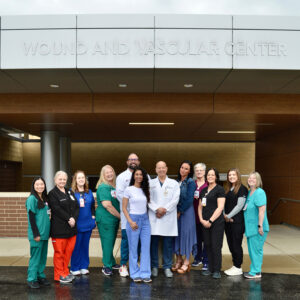Walk through the doors of the Wound Center at Johnson Memorial Health in Franklin, Indiana, and you’re stepping into more than a clinic—you’re entering a space where science meets compassion, where state-of-the-art medicine meets human connection, over a decade in the making. Dr. Dana, the Wound Center’s medical director and the hospital’s chief of staff, is proud of the work they’ve done at the Wound Center since its opening almost four years ago.
Believe it or not, the Wound Center occupies what used to be Johnson Memorial’s emergency department at 1125 W. Jefferson St. “We have one of the most comprehensive vascular centers, probably in the country,” says Dr. Dana. “It developed over ten years ago. I worked here for 11 years in the ER. Over time, I transitioned into wound and vascular medicine.”
That transition—from ER to specialized wound care center—didn’t happen overnight. It began through a partnership program that steadily expanded. Roughly four years ago, the team moved into their current space to meet growing demand and to offer even more comprehensive services. Today, the Wound Center has earned the distinction of being named a Center of Excellence by Healogics, an organization overseeing more than 800 wound care centers worldwide.
That recognition is based on patient outcomes and satisfaction. Dr. Dana explains: “Wound healing within a specific timeframe is crucial. We’re focused on finding the root cause of wounds and addressing it effectively.”
The work done by Dr. Dana and his team is part medicine, part life-changing mystery solving. “Patients usually have chronic wounds,” Dr. Dana says. “What makes this field enjoyable is that it’s like being an investigator—there’s always a reason a wound doesn’t heal. Is it infectious? Inflammatory? A vascular issue? Once you identify the cause, then you can treat it.”
Evaluations start with a detailed patient history, physical exams, and often vascular studies, biopsies, or other in-depth diagnostics. “It can take one to three weeks to complete the evaluation,” he says, “but by the end of that, we usually have a full picture.”
That holistic view isn’t accidental—Dr. Dana is a DO (doctor of osteopathy), trained in internal medicine with an emphasis on looking at the full system. “It gives me a holistic perspective. There’s usually an underlying cause for a wound, and that’s what we investigate.”
The Wound Center isn’t just a single-provider practice. It’s a carefully orchestrated collaboration between specialists. Dr. Dana is at the core of the Wound Center, along with foot and ankle specialist Dr. Fisher, nurse practitioner specializing in wound care Amy Dippel, and Dr. Christie and Dr. Roese overseeing vascular care. Their team also includes dedicated vascular ultrasound technologist Necla Rasor, who helps coordinate the center’s vascular program. “We work closely with podiatry, ankle reconstructive surgeons, vascular surgeons, and specialized techs.”
That teamwork pays off—especially for patients who might otherwise bounce between specialists. “All of the ordered testing is done here in-house,” Necla Rasor says. “We can usually bring the patient back within a week, or even the same day. It’s a one-stop shop!”
This seamless coordination allows the team to quickly diagnose and begin treatment—whether that involves a surgical procedure, vascular intervention, or one of the center’s advanced healing techniques.
One of the most powerful tools in the Wound Center’s arsenal is hyperbaric oxygen therapy (HBOT). Program director Monique Fernstrom explains that HBOT is “a cutting-edge treatment that accelerates the healing process for complex wounds.” Patients lie inside a clear chamber and breathe 100% oxygen at high pressure for 90 minutes. Most do this up to 40 times over several weeks. “It helps oxygenate tissue and encourages new blood vessel growth,” Dr. Dana explains. “It’s a game-changer for certain patients.”
In addition to HBOT, the center offers leading-edge options like tissue substitutes, tissue grafts, and reconstructive surgery. These are not band-aid solutions—they’re long-term, evidence-based treatments that address wounds at their root.
The most common underlying issue? Chronic venous insufficiency, a condition where leg vein valves become dysfunctional, leading to swelling, pain, and ultimately, wounds. Symptoms can be subtle at first, such as leg heaviness, fatigue, burning, swelling, or restlessness. But left untreated, these signs can lead to non-healing wounds that impact mobility and quality of life.
Chronic conditions like diabetes and obesity also play a significant role in wound development. These systemic issues make it harder for the body to heal, turning what should be minor injuries into chronic health problems.
While some patients come in directly, it’s generally best to go through a primary care provider due to insurance logistics. Either way, each patient is treated with the compassion and care they’ve been seeking. Once patients begin treatment, they’re not just numbers in a system—they become part of the Wound Center’s community.
One of the most meaningful aspects of care at Johnson Memorial’s Wound Center is how healing is celebrated. When a patient completes their treatment, they’re given a gift bag—but the real reward is intangible. Necla Rasor describes the relationship built: “We definitely build a bond, and they know to call us back if they have any questions or new symptoms. They don’t hesitate to reach right back out to us. It’s almost like a family.” Some patients have been dealing with wounds for months or years, so when they finally heal thanks to the team at the Wound Center, it’s a group celebration and affirmation for all!
Dr. Dana agrees. “It took time to build this program—over a decade. But with the right leadership and the right team, amazing things happen. Our focus is patient care and outcomes. That’s what drives us.”
At its core, the Wound Center at Johnson Memorial Health is about much more than healing skin. It’s about restoring lives. It’s about a former ER transformed into a place of renewal. And it’s about a team of dedicated experts working together to solve the kind of problems that others often miss. They don’t just patch up wounds. They dig deeper. They ask why. And in doing so, they’re helping their patients do something truly extraordinary: heal for good.





